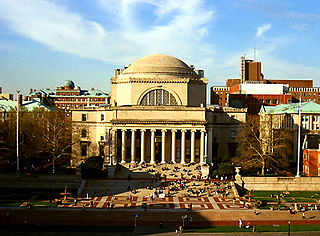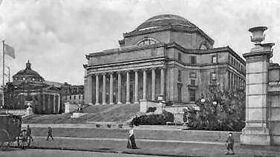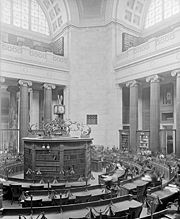
Low Memorial Library
Encyclopedia
The Low Memorial Library is the administrative center of Columbia University
. Built in 1895 by University President Seth Low
in memory of his father, Abiel Abbot Low
, and financed with $1 million of Low's own money due to the recalcitrance of university alumni, it is the focal point and most prominent building on the university's Morningside Heights campus. The steps leading to the library's columned facade are a popular meeting place for Columbia students, as well as home to Daniel Chester French
's sculpture, Alma Mater, a university symbol. Low Library was officially named a New York City landmark
in 1967, then a National Historic Landmark
20 years later.
It is capped by the largest freestanding granite dome in the United States.
, which was responsible for the design of much of Columbia's Morningside Heights campus. The library was designed in the neo-classical style
, incorporating many of the elements of Rome's Pantheon
. The building is in the shape of a Greek Cross and features windows modelled on those of the Baths of Diocletian
. The columns on the library's front facade are in the Ionic order
, suited to institutions of arts and letters. An inscription on the building's attic
describes the history of the university. It reads:
 The interior abounds with classical references. At the entryway are bronze busts of Zeus
The interior abounds with classical references. At the entryway are bronze busts of Zeus
and Apollo
. The foyer
contains a white marble bust of Pallas Athena, modeled after the Minerve du Collier at the Louvre
and donated by Jonathan Ackerman Coles of the Columbia College Class of 1864, an alumnus of Columbia's Philolexian Society
. She is surrounded there by the twelve signs of the zodiac. The 106 feet (32.3 m) rotunda, formerly the library reading room when the building was used for its original function, is lined with columns of solid green Connemara marble from Ireland, topped with gold capitals. Roman and Greek philosophers Demosthenes
, Euripides
, Sophocles
, and Augustus Caesar stare down from the rotunda's heights as the four points of knowledge, Law, Philosophy, Medicine, and Theology mark the four points of the Greek Cross. The rest of the interior is finished with Italian and Istrian marble.
A late-19th century real estate magazine, believing Low to be patterned after a French church by "the architect Rumpf", criticised the design, writing that "there is scarcely any original designing done in this city, except the vagaries of the incompetent. The rest is mostly a copybook reproduction of classical and other detail. Successful architects have too much to do to be pre-eminently artists -- they must be first-rate men of business."
 The first building on Columbia's new Morningside campus when it was built in 1895, rising out of cropfields, Low originally served as the university's main library, a role which ended when it was supplanted by the larger Butler Library
The first building on Columbia's new Morningside campus when it was built in 1895, rising out of cropfields, Low originally served as the university's main library, a role which ended when it was supplanted by the larger Butler Library
in 1934. After a period in which it still housed the university's archives, the building now consists almost solely of administrative offices. Confusingly, however, the building's facade is still etched with the words "The Library of Columbia University," leading many to mistakenly believe that it retains its earlier role.
 During the 1968 Columbia protests
During the 1968 Columbia protests
, Low was occupied by students objecting to, among other things, the proposed construction of a university-owned gymnasium in Morningside Park as well as Columbia's involvement with the Vietnam War
. Within Low, the students barricaded themselves inside the office of University President Grayson L. Kirk
, where they sifted for documents. Dramatic scenes ensued, including attempts to catapult food to the protesters and efforts by their adversaries to cordon them off. The access of Columbia media outlets such as WKCR
and the Columbia Daily Spectator
that allowed them to break stories relating to the events in Low prior to national news organizations remains a mystery; many believe students had access to secret tunnels
. The protesters were only removed after a controversially violent assault on the building by the New York Police Department.
In 1954, during the University's bicentennial, Low Library was commemorated on a postage stamp. For the University's semiquencentennial in 2004, it was placed on a stamped postal card.
Columbia University
Columbia University in the City of New York is a private, Ivy League university in Manhattan, New York City. Columbia is the oldest institution of higher learning in the state of New York, the fifth oldest in the United States, and one of the country's nine Colonial Colleges founded before the...
. Built in 1895 by University President Seth Low
Seth Low
Seth Low , born in Brooklyn, New York, was an American educator and political figure who served as mayor of Brooklyn, as President of Columbia University, as diplomatic representative of the United States, and as Mayor of New York City...
in memory of his father, Abiel Abbot Low
Abiel Abbot Low
Abiel Abbot Low was an American entrepreneur, businessman, trader and philanthropist who gained most of his fortune from the China trade, importing teas, porcelains, and silk, and building and operating a fleet of reputable clipper ships.- Early life :Abiel Abbot Low was one of twelve children of...
, and financed with $1 million of Low's own money due to the recalcitrance of university alumni, it is the focal point and most prominent building on the university's Morningside Heights campus. The steps leading to the library's columned facade are a popular meeting place for Columbia students, as well as home to Daniel Chester French
Daniel Chester French
Daniel Chester French was an American sculptor. His best-known work is the sculpture of a seated Abraham Lincoln at the Lincoln Memorial in Washington, D.C.-Life and career:...
's sculpture, Alma Mater, a university symbol. Low Library was officially named a New York City landmark
New York City Landmarks Preservation Commission
The New York City Landmarks Preservation Commission is the New York City agency charged with administering the city's Landmarks Preservation Law. The Commission was created in April 1965 by Mayor Robert F. Wagner following the destruction of Pennsylvania Station the previous year to make way for...
in 1967, then a National Historic Landmark
National Historic Landmark
A National Historic Landmark is a building, site, structure, object, or district, that is officially recognized by the United States government for its historical significance...
20 years later.
It is capped by the largest freestanding granite dome in the United States.
Architecture
Low Library was designed by the architectural firm of McKim, Mead, and WhiteMcKim, Mead, and White
McKim, Mead & White was a prominent American architectural firm at the turn of the twentieth century and in the history of American architecture. The firm's founding partners were Charles Follen McKim , William Rutherford Mead and Stanford White...
, which was responsible for the design of much of Columbia's Morningside Heights campus. The library was designed in the neo-classical style
Neoclassical architecture
Neoclassical architecture was an architectural style produced by the neoclassical movement that began in the mid-18th century, manifested both in its details as a reaction against the Rococo style of naturalistic ornament, and in its architectural formulas as an outgrowth of some classicizing...
, incorporating many of the elements of Rome's Pantheon
Pantheon, Rome
The Pantheon ,Rarely Pantheum. This appears in Pliny's Natural History in describing this edifice: Agrippae Pantheum decoravit Diogenes Atheniensis; in columnis templi eius Caryatides probantur inter pauca operum, sicut in fastigio posita signa, sed propter altitudinem loci minus celebrata.from ,...
. The building is in the shape of a Greek Cross and features windows modelled on those of the Baths of Diocletian
Baths of Diocletian
The Baths of Diocletian in Rome were the grandest of the public baths, or thermae built by successive emperors. Diocletian's Baths, dedicated in 306, were the largest and most sumptuous of the imperial baths. The baths were built between the years 298 AD and 306 AD...
. The columns on the library's front facade are in the Ionic order
Ionic order
The Ionic order forms one of the three orders or organizational systems of classical architecture, the other two canonic orders being the Doric and the Corinthian...
, suited to institutions of arts and letters. An inscription on the building's attic
Attic style
In classical architecture, the term attic refers to a story or low wall above the cornice of a classical façade. This usage originated in the 17th century from the use of Attica style pilasters as adornments on the top story's façade...
describes the history of the university. It reads:
King's College Founded in the Province of New York
By Royal Charter in the Reign of George II
Perpetuated as Columbia College by the People of the State of New York
When they became Free and Independent - Maintained and Cherished from Generation to Generation
For the Advancement of the Public Good and the Glory of Almighty God

Zeus
In the ancient Greek religion, Zeus was the "Father of Gods and men" who ruled the Olympians of Mount Olympus as a father ruled the family. He was the god of sky and thunder in Greek mythology. His Roman counterpart is Jupiter and his Etruscan counterpart is Tinia.Zeus was the child of Cronus...
and Apollo
Apollo
Apollo is one of the most important and complex of the Olympian deities in Greek and Roman mythology...
. The foyer
Foyer
A foyer or lobby is a large, vast room or complex of rooms adjacent to the auditorium...
contains a white marble bust of Pallas Athena, modeled after the Minerve du Collier at the Louvre
Louvre
The Musée du Louvre – in English, the Louvre Museum or simply the Louvre – is one of the world's largest museums, the most visited art museum in the world and a historic monument. A central landmark of Paris, it is located on the Right Bank of the Seine in the 1st arrondissement...
and donated by Jonathan Ackerman Coles of the Columbia College Class of 1864, an alumnus of Columbia's Philolexian Society
Philolexian Society
The Philolexian Society of Columbia University is one of the oldest college literary societies in the United States, and the oldest student group at Columbia...
. She is surrounded there by the twelve signs of the zodiac. The 106 feet (32.3 m) rotunda, formerly the library reading room when the building was used for its original function, is lined with columns of solid green Connemara marble from Ireland, topped with gold capitals. Roman and Greek philosophers Demosthenes
Demosthenes
Demosthenes was a prominent Greek statesman and orator of ancient Athens. His orations constitute a significant expression of contemporary Athenian intellectual prowess and provide an insight into the politics and culture of ancient Greece during the 4th century BC. Demosthenes learned rhetoric by...
, Euripides
Euripides
Euripides was one of the three great tragedians of classical Athens, the other two being Aeschylus and Sophocles. Some ancient scholars attributed ninety-five plays to him but according to the Suda it was ninety-two at most...
, Sophocles
Sophocles
Sophocles is one of three ancient Greek tragedians whose plays have survived. His first plays were written later than those of Aeschylus, and earlier than or contemporary with those of Euripides...
, and Augustus Caesar stare down from the rotunda's heights as the four points of knowledge, Law, Philosophy, Medicine, and Theology mark the four points of the Greek Cross. The rest of the interior is finished with Italian and Istrian marble.
A late-19th century real estate magazine, believing Low to be patterned after a French church by "the architect Rumpf", criticised the design, writing that "there is scarcely any original designing done in this city, except the vagaries of the incompetent. The rest is mostly a copybook reproduction of classical and other detail. Successful architects have too much to do to be pre-eminently artists -- they must be first-rate men of business."
History

Butler Library
The Nicholas Murray Butler Library, commonly known simply as Butler Library, is the largest single library in the Columbia University Library System, which contains over 9.3 million books, and is one of the largest buildings on the Morningside Heights campus of Columbia University.Proposed as...
in 1934. After a period in which it still housed the university's archives, the building now consists almost solely of administrative offices. Confusingly, however, the building's facade is still etched with the words "The Library of Columbia University," leading many to mistakenly believe that it retains its earlier role.

Columbia University protests of 1968
The Columbia University protests of 1968 were among the many student demonstrations that occurred around the world in that year. The Columbia protests erupted over the spring of that year after students discovered links between the university and the institutional apparatus supporting the United...
, Low was occupied by students objecting to, among other things, the proposed construction of a university-owned gymnasium in Morningside Park as well as Columbia's involvement with the Vietnam War
Vietnam War
The Vietnam War was a Cold War-era military conflict that occurred in Vietnam, Laos, and Cambodia from 1 November 1955 to the fall of Saigon on 30 April 1975. This war followed the First Indochina War and was fought between North Vietnam, supported by its communist allies, and the government of...
. Within Low, the students barricaded themselves inside the office of University President Grayson L. Kirk
Grayson L. Kirk
Grayson Louis Kirk was president of Columbia University during the Columbia University protests of 1968. He was also a Professor of Government, advisor to the State Department, and instrumental in the formation of the United Nations.-Early life:Kirk was born to a farmer and schoolteacher in...
, where they sifted for documents. Dramatic scenes ensued, including attempts to catapult food to the protesters and efforts by their adversaries to cordon them off. The access of Columbia media outlets such as WKCR
WKCR
WKCR-FM is a radio station. Licensed to New York, New York, USA, it serves the New York area. The station is currently owned by Trustees of Columbia University in New York.-History:...
and the Columbia Daily Spectator
Columbia Daily Spectator
Columbia Daily Spectator is the daily student newspaper of Columbia University. It is published at 112th and Broadway in New York, New York. Founded in 1877, it is the oldest continuously operating college news daily in the nation after The Harvard Crimson, and has been legally independent of the...
that allowed them to break stories relating to the events in Low prior to national news organizations remains a mystery; many believe students had access to secret tunnels
Columbia University Tunnels
Columbia University has an extensive tunnel system connecting most buildings on campus and acting as conduits for steam, electricity, telecommunications, and other infrastructure. The oldest tunnels are from the mental asylum that existed before the Morningside Campus was built...
. The protesters were only removed after a controversially violent assault on the building by the New York Police Department.
In 1954, during the University's bicentennial, Low Library was commemorated on a postage stamp. For the University's semiquencentennial in 2004, it was placed on a stamped postal card.

